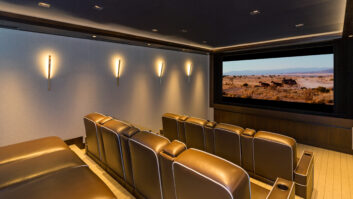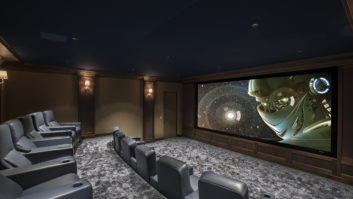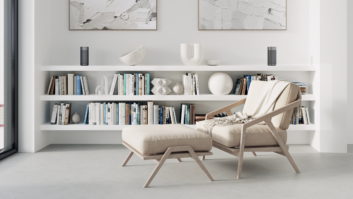Despite war, terrorism and a pending presidential election, at least one market has not only remained secure, it has flourished. Last year, U.S. home sales reached record highs, thanks to low mortgage rates. Low rates also drove new home construction, which totaled 1.848 million units in 2003-the highest in 25 years, according to the Commerce Department.
Indeed, the deals were too good to ignore.
This year, mortgage rates are expected to increase. While this will have a direct impact on refinancing and, to a degree, home sales, industry insiders remain optimistic.
This is great news for custom installation companies and builders alike. And, as homeowners continue to place greater emphasis on their desire for integrated audio, video and networking systems, the relationship between builders and custom installers becomes increasingly important.
Andrew Byers, project manager at La Scala Integrated Media Inc. (www.lascala.ca), a custom installation firm in Vancouver, British Columbia, aims to make the builder’s job as easy as possible. “Ideally, what we try to do is make things simpler for the builder, because what he doesn’t want to have are extra complications,” he said. Byers efficiently organizes installation projects so that the builder deals directly with him and, if necessary, a sales representative.
Supplying accurate documentation at the right time is one way to win a builder’s heart, Byers notes. In many cases, this requires installers to remain in contact with not only the builder, but other trades, such as the electrical contractor.
Byers describes the ideal scenario: “What we would do is talk to the builder early on and find out who the electrician is so that we can set up a meeting involving both the builder and the electrician,” he explained. “That way, we can review things so that nothing comes as a surprise to anyone.”
The builder’s ultimate goal is to remain on schedule; if it is perceived that the custom installation company is holding things up, the builder-installer relationship will suffer.
“The key factor that any builder is worried about is the timeline,” Byers said. “The timelines are pretty tight, and builders don’t want to see any changes that have a potential effect on the timeline.” Ensuring early on that electronic components will physically fit into the space, and resolving any heating and ventilation issues associated with the equipment, helps installers to avoid this problem.
Sean Fields, president of the custom installation firm Audio/Video Entertainment Inc. (www.aveonline.tv), in Laguna Niguel, California, puts it another way. “Builders are on a very tight timeline that moves quickly,” he said. “The integrator must have a system to deal with this reality. The integrator must realize that they are a part of a larger system, and that they must operate within that system. If they hold up production, they will not be a contractor for very long.”
Still, timelines can be a different animal, and one that is difficult to control. “There is a tendency in the building industry, in general, to be far too optimistic with timelines,” Byers observed. “That is a struggle, particularly if you are a company like ours, where we are juggling a number of different jobs and we try to figure out if we can take on a new job based on the work that we have to complete, when we don’t even know when that work really needs to be completed.”
As is the case with all relationships, maintaining clear lines of communication is the secret to making the builder-installer relationship work. “Go to the site on a regular basis and see what is going on,” Byers said. “Keep an eye on what the other trades are doing; make sure the mill worker has sent you his design when he is finished, and that he has incorporated what you need into it.”
One of the most significant challenges that custom installation companies continue to face is that builders don’t fully understand what integrated systems are all about. “Many people aren’t even aware that many of the simpler systems-like lighting control-are an option for them,” Byers said. “A lot of builders are not aware of how these systems work.”
Mark Weisenberg points to this industry’s responsibility to inform the right people on what custom installation is all about. Weisenberg is national sales director at Integra Research (www.integraresearch.com) and active member of the Distributed Audio Alliance (www.multiroomaudio.org), an initiative that aims to raise awareness among builders and buyers about multi-room audio. “There is a need for our industry to educate in terms of how to best implement this technology into homes,” he said. “What we can do as an industry is continue to communicate and educate the builders and go where they are meeting: the National Builders Show and National Association of Homebuilders chapter meetings.
There are lots of opportunities for dealers to speak at these local meetings to expose local builders to low voltage and, more importantly, to the contractors that supply that service.”
AVAD is doing just that with its new Dealer to Builder (D2B) program. The technology distribution company, which is based in Fort Lauderdale, Florida, recently presented this initiative at the International Builder’s Show in Las Vegas, Nevada after unveiling it to custom integrators at CEDIA.
D2B is focused on addressing the concerns of builders who, as a result of customer demand, are seeking to expand their service roster to include electronic systems. AVAD has developed a number different “packages” made up of home theater, distributed audio/video and central vacuum systems; builders who are interested in implementing these packages into their homes may do so through an AVAD-certified electronic systems contractor.
“The International Builder’s Show was the ideal setting to kick off the current phase of our Dealer to Builder program,” said Joe Piccirilli, managing director of AVAD. “We showed attending builders how D2B creates viable opportunities to set the pace in their highly competitive market, and they were very excited about getting involved.”
Russound’s Peter Hoagland, who is the former chair of and continues to be an active partner in the Distributed Audio Alliance, suggests that when educating people about residential systems, custom installers should avoid getting overly technical. “We have to sell our products based on benefits and what they do for the end users,” he said. “In the case of the home buyer, they are trying to evaluate so many different things, and we might be sandwiched in between countertops and plumbing fixtures. We have to make very concise sales propositions, which means that we would give them three or four things that they need to know.”
After all, most homeowners are interested in improving their lifestyle, not learning technical specifications. “I see more of a trend toward not listing what we offer, but the benefits of what we offer-more of a marketing approach to lifestyle and the benefit of technology,” said Jane Hauck, director of the design studio at Brookfield Homes (www.brookfieldhomes.com) in Costa Mesa, California. “We are selling a lifestyle; there is no question today that the buyer is looking for lifestyle.”
Some builders are reticent about involving custom installation companies based on negative experiences they have had in the past. “You may come across a builder who had some work done, and for whatever reason, the outcome wasn’t that positive,” Byers illustrated. “When you come on the job, there is this preconception that you are going to come in and things aren’t going to work right, and it’s all going to fall back on the builder. The best thing we can do is to show them how organized we are, and prove to them that we are on it, professional, and that we are not only going to look after them, but also the best interests of their client.”
Weisenberg agrees. “Low-voltage contractors will not have a second chance to make a first impression with builders, so as an industry we have to continue to put our best foot forward with business practices,” he said. “It’s only in that way that builders will accept our services and be willing to incorporate our products into their homes. We need to be aware of their challenges and concerns, and overcome them by being better businesspeople.”
Carolyn Heinze ([email protected]) works from her office in Vancouver, Canada.







